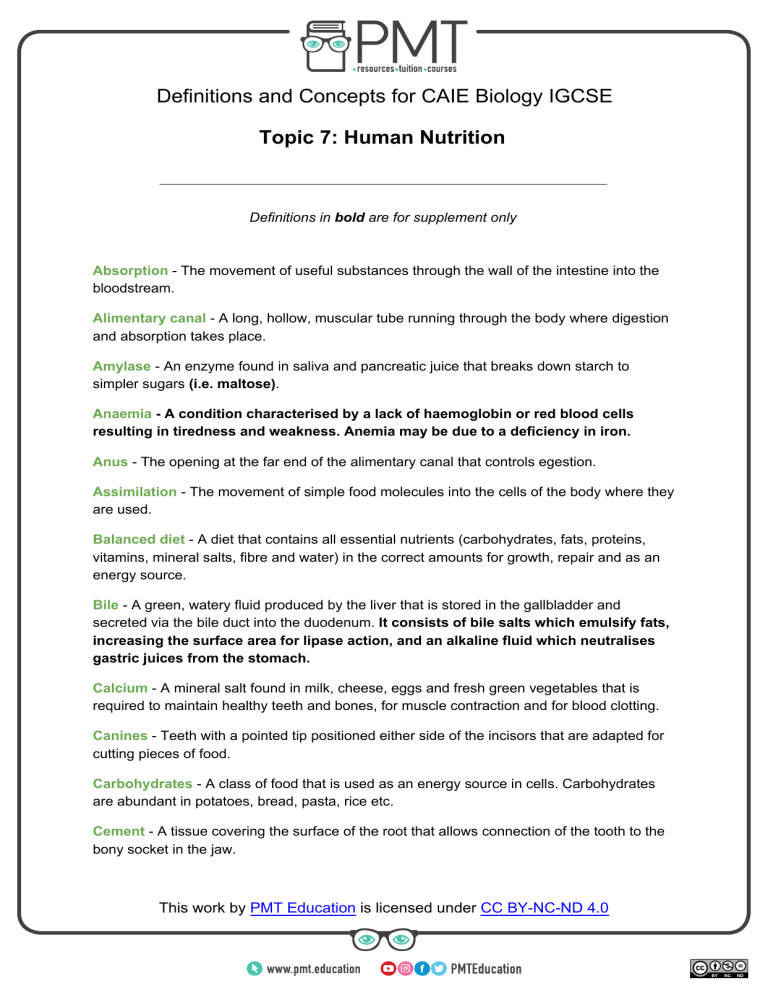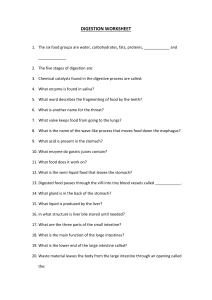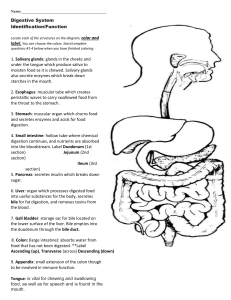
Definitions and Concepts for CAIE Biology IGCSE Topic 7: Human Nutrition Definitions in bold are for supplement only Absorption - The movement of useful substances through the wall of the intestine into the bloodstream. Alimentary canal - A long, hollow, muscular tube running through the body where digestion and absorption takes place. Amylase - An enzyme found in saliva and pancreatic juice that breaks down starch to simpler sugars (i.e. maltose). Anaemia - A condition characterised by a lack of haemoglobin or red blood cells resulting in tiredness and weakness. Anemia may be due to a deficiency in iron. Anus - The opening at the far end of the alimentary canal that controls egestion. Assimilation - The movement of simple food molecules into the cells of the body where they are used. Balanced diet - A diet that contains all essential nutrients (carbohydrates, fats, proteins, vitamins, mineral salts, fibre and water) in the correct amounts for growth, repair and as an energy source. Bile - A green, watery fluid produced by the liver that is stored in the gallbladder and secreted via the bile duct into the duodenum. It consists of bile salts which emulsify fats, increasing the surface area for lipase action, and an alkaline fluid which neutralises gastric juices from the stomach. Calcium - A mineral salt found in milk, cheese, eggs and fresh green vegetables that is required to maintain healthy teeth and bones, for muscle contraction and for blood clotting. Canines - Teeth with a pointed tip positioned either side of the incisors that are adapted for cutting pieces of food. Carbohydrates - A class of food that is used as an energy source in cells. Carbohydrates are abundant in potatoes, bread, pasta, rice etc. Cement - A tissue covering the surface of the root that allows connection of the tooth to the bony socket in the jaw. https://bit.ly/pmt-edu-cc This work by PMT Education is licensed under https://bit.ly/pmt-cc CC BY-NC-ND 4.0 https://bit.ly/pmt-edu https://bit.ly/pmt-cc https://bit.ly/pmt-cc Chemical digestion - A type of digestion that involves breaking down large, insoluble molecules into smaller, soluble molecules using enzymes. Cholera - A water-borne disease caused by the bacterium Vibrio cholerae, the toxins of which secrete chloride ions into the small intestine causing severe diarrhoea and leading to dehydration. Colon - The first section of the large intestine that reabsorbs water and bile salts from the waste material. Constipation - A condition characterised by difficulty with defecation. This may be due to a diet lacking in fibre. Coronary heart disease - A disease caused by the build-up of fatty deposits inside the coronary arteries, narrowing them and reducing blood flow to the heart tissue. It is as a result of a diet high in saturated fats. Crown - The part of the tooth that is visible above the gum level. Dental caries - A disease of the tooth involving the conversion of sugars to acids by bacteria on the tooth surface. This dissolves the enamel, forming cavities. Dentine - A hard bony tissue underlying the enamel. It is softer than enamel. Diarrhoea - A condition in which loose, watery stools are egested frequently. It is treated using oral rehydration therapy. Duodenum - The first section of the small intestine which receives pancreatic juice for the chemical digestion of proteins, lipids and starch, and the neutralisation of stomach acid. It also receives bile from the gall bladder. Egestion - The removal of undigested waste material as faeces from the body. Enamel - The hard outer coating of the crown of the tooth. Fats - A class of food that has a variety of roles in organisms including insulation, structure, protection of organs and energy storage. Animal fats are abundant in meat, milk, cheese and egg yolk. Plant fats are found as oils in fruits and seeds and are used to make margarine. Fibre - A complex carbohydrate found in plant-based foods that provides bulk, softening the faeces and supporting regular bowel movements. A diet lacking in fibre may result in constipation. Gall bladder - An organ that stores bile produced in the liver. It secretes bile into the duodenum via the bile duct. Gastric juice - A digestive juice secreted from glands in the stomach lining that contains proteases for the chemical digestion of proteins to amino acids. Hydrochloric acid dissolves in gastric juice, forming a weak solution. https://bit.ly/pmt-edu https://bit.ly/pmt-cc https://bit.ly/pmt-cc Gum - The tissue that overlies the jaw bone inside of the mouth. Hydrochloric acid - A chemical found in gastric juice that kills harmful microorganisms in food (via enzyme denaturation) and provides an optimum pH for enzyme (pepsin) activity. Ileum - The second section of the small intestine that serves as the main site of absorption of the products of digestion. Enzymes in the epithelial lining chemically digest peptides and maltose. Incisors - Chisel-shaped teeth at the front of the mouth adapted for cutting pieces of food. Ingestion - The process by which organisms take food and drink into their bodies through the mouth. Iron - A mineral salt found in red meat, eggs, nuts, wholegrains and fresh green vegetables that is required for the production of haemoglobin in red blood cells. A deficiency in iron leads to anaemia. Kwashiorkor - A form of severe protein-energy malnutrition due to a diet insufficient in protein. It is characterised by dry skin, a swollen belly, weakness, changes to hair colour and irritability. Lactation - The production and secretion of breast milk to feed a baby. Lacteals - The lymphatic vessels of the small intestine through which digested fats enter the lymphatic system. Large intestine - An organ in the alimentary canal where water is reabsorbed from the waste material stored as faeces. It is made up of the colon and the rectum. Lipase - An enzyme found in pancreatic juice that breaks down fats to fatty acids and glycerol. Liver - An organ that produces and secretes bile into the gallbladder. In the liver, digested foods (e.g. glucose) are assimilated and excess amino acids are deaminated. Malnutrition - A condition resulting from a diet lacking in, or too rich in nutrients. Maltase - An enzyme located on the membranes of the epithelial lining of the small intestine that breaks down maltose to glucose. Marasmus - An acute form of malnutrition due to a diet insufficient in carbohydrate and protein. It is characterised by reduced fat and muscle tissue (without tissue swelling) and thin skin which hangs in folds. Mechanical digestion - A type of digestion that involves physically breaking down food into smaller pieces. This increases the surface area for chemical digestion. Microvilli - Protrusions of the epithelial cell membrane that provide a large surface area for absorption in the ileum. https://bit.ly/pmt-edu https://bit.ly/pmt-cc https://bit.ly/pmt-cc Molars - Teeth with four or five cusps positioned at the back of the mouth. They have two or three roots and are adapted for chewing and grinding food. Mouth - The upper opening of the alimentary canal through which food enters the body. Mechanical and chemical digestion of starch take place here. Obesity - The abnormal or excessive accumulation of fatty deposits under the skin or in the abdomen. It is generally as a result of eating too much and exercising too little. Oesophagus - A muscular tube that carries food from the mouth to the stomach by peristalsis. Oral rehydration therapy - A treatment for dehydration that involves drinking plenty of fluids containing water, salts and sugars. Pancreas - A gland situated behind the stomach that - via the pancreatic duct - secretes pancreatic juice into the duodenum. Pancreatic juice - A digestive juice secreted from the pancreas into the duodenum that contains a variety of enzymes for the chemical digestion of proteins, lipids and starch. It also contains sodium hydrogencarbonate which partially neutralises gastric juices from the stomach. Pepsin - A protease enzyme secreted in the stomach that breaks down proteins into peptides. Peristalsis - The contraction of the circular muscle behind the bolus of food and the relaxation of the longitudinal muscle in front, forcing food down the gut. Premolars - Teeth with two cusps positioned behind the canines and in front of the molars. They have one or two roots and are adapted for tearing and grinding food. Protease - An enzyme found in the stomach and small intestine that breaks down protein to amino acids. There are two types of protease enzymes: pepsin and trypsin. Proteins - A class of food that is required for the growth and repair of cells. Important sources of protein include lean meat, fish, milk, eggs, cheese, seeds and nuts. Pulp cavity - The inner chamber of the tooth containing nerves, blood vessels and connective tissue, collectively known as pulp. Rectum - The second segment of the large intestine that stores faeces prior to egestion. Rickets - A condition characterised by weak and soft bones in children due to a deficiency in vitamin D which prevents the deposition of calcium salts in the bones. Saliva - An extracellular fluid secreted by the salivary glands that lubricates the food and causes small pieces to stick together to form a bolus. It also contains the enzyme amylase. https://bit.ly/pmt-edu https://bit.ly/pmt-cc https://bit.ly/pmt-cc Salivary glands - Glands in the oral cavity that secrete saliva containing amylase for chemical digestion. Scurvy - A deficiency disease resulting from a lack of vitamin C. Symptoms include bleeding under the skin and around gums, stunted growth in children, and very dry skin and hair. Small intestine - An organ in the alimentary canal where digestive enzymes and bile are mixed with food and the resulting digested materials are absorbed into the bloodstream. It is made up of the duodenum and the ileum. Starvation - A severe lack of food that is insufficient to meet the body’s energy needs. It results in weight loss, organ damage, muscle atrophy and eventually death. Stomach - A muscular organ that receives food from the oesophagus. Mechanical digestion (mixing and grinding) and chemical digestion of protein occur here. It also contains hydrochloric acid to kill bacteria. Trypsin - A protease enzyme secreted by the pancreas (in an inactive form) into the duodenum where it is activated and breaks down proteins into peptides. Villi - Finger-like projections on the surface of the ileum wall that provide a large surface area for the absorption of food. Vitamin C - A vitamin found in citrus fruits, fresh green vegetables, tomatoes and potatoes that is required to protect cells and maintain healthy connective tissue, blood vessels, bones and cartilage. A deficiency in vitamin C leads to scurvy. Vitamin D - A vitamin found in dairy products, egg yolk and oily fish that is required to maintain healthy bones and teeth. The body can also manufacture vitamin D when exposed to sunlight. A deficiency in vitamin D leads to rickets. Vitamins - A group of organic substances which are required for the maintenance of health and the functioning of an organism’s metabolism. Water - An essential nutrient found in the cytoplasm. It is an important solvent in organisms. https://bit.ly/pmt-edu https://bit.ly/pmt-cc https://bit.ly/pmt-cc









